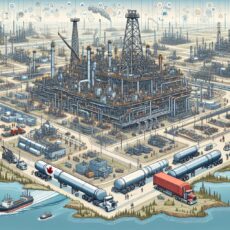The oil and gas industry in Canada has always been a topic of great interest and debate. As one of the largest energy producers in the world, Canada plays a crucial role in meeting global energy demands. However, the industry is not without its fair share of challenges and controversies. In this article, we will take a closer look at the ups and downs of Canada’s oil and gas sector, examining its impact on the economy, environment, and people.
Canada’s oil and gas industry has experienced remarkable growth over the past few decades. The discovery of vast oil reserves in the province of Alberta, particularly in the oil sands, has transformed the country into a major player in the global energy market. With an estimated 171 billion barrels of proven oil reserves, Canada ranks third behind Venezuela and Saudi Arabia.
This boom in the oil and gas sector has had a significant impact on the Canadian economy. It has created numerous job opportunities, attracting professionals from various fields to work in the industry. According to the Canadian Association of Petroleum Producers (CAPP), the oil sands industry alone supports more than 500,000 direct and indirect jobs across Canada.
Additionally, the industry contributes significantly to the country’s GDP. In 2018, it accounted for around 5% of Canada’s GDP, generating billions of dollars in revenue and tax revenues for the government. This revenue has enabled the funding of essential public services and infrastructure development, benefiting Canadians across the country.
However, the oil and gas industry in Canada also faces various challenges and controversies. One of the main concerns surrounding the sector is its environmental impact. Oil sands extraction, in particular, has been criticized for its high greenhouse gas emissions and water consumption. Environmentalists argue that the industry’s expansion poses a threat to Alberta’s freshwater resources and contributes to climate change.
Moreover, the transportation of oil and gas products raises safety concerns. The construction of pipelines, such as the controversial Keystone XL and Trans Mountain pipelines, has been met with strong opposition from indigenous communities and environmental activists. The fear of pipeline leaks and spills, which can have devastating effects on ecosystems and communities, raises questions about the long-term sustainability of the industry.
The oil and gas industry’s dependency on global oil prices also exposes it to volatile market fluctuations. In recent years, the sector has faced significant challenges due to plummeting oil prices, resulting in layoffs and reduced investments. The 2014 oil price crash led to a major downturn in the industry, affecting not only companies but also the livelihoods of many Canadians who depend on the sector for employment.
Despite the challenges, the Canadian oil and gas industry remains resilient and adaptable. Companies are continually exploring innovative technologies and practices to minimize their environmental footprint and improve efficiency. Investments in renewable energy projects and initiatives are also gaining momentum, signaling a shift towards a more sustainable and diversified energy future.
In conclusion, the oil and gas industry in Canada is a complex and multifaceted sector that has its fair share of positives and negatives. While it has contributed significantly to the country’s economy and energy security, it also faces challenges related to the environment, safety, and market volatility. As Canada strives for a sustainable future, finding the right balance between economic growth and environmental stewardship will be crucial for the long-term success of the industry. By embracing innovation and embracing renewable energy, the oil and gas industry can forge a path towards a cleaner and more prosperous future for all Canadians.


